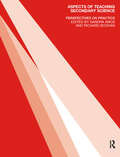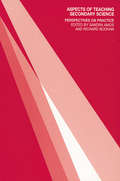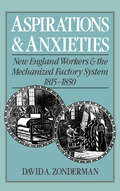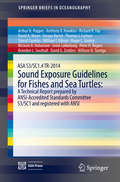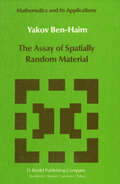- Table View
- List View
Aspects of Teaching Secondary Design and Technology: Perspectives on Practice
by Gwyneth Owen-JacksonBeginning by outlining the national curriculum for design and technology, Aspects of Teaching Secondary Design and Technology goes on to look at what design and technology is in the primary school, at examination level and post-16. Vocational qualifications relevant to design and technology are also discussed. There are chapters looking at the relationship between design and technology and the wider social and cultural context. The development of cross-curricular skills and value judgements are discussed as are sustainability and the role of the community in the teaching and learning of design and technology. Together, these articles comprise a sound guide to good classroom practice, related to the requirements of the curriculum, and rooted in the professional perspectives of experienced teachers.
Aspects of Teaching Secondary Science: Perspectives on Practice
by Sandra Amos Richard BoohanThis book's structure reflects the different dimensions to learning science. The first section focuses on the importance of talk in the science classroom, while the second explores the key role of practical work. The third section is concerned with the creative, theoretical aspect of science. Section four follows this by considering the communication of ideas and how pupils learn to participate in the discourse of the scientific community. Section five emphasizes the place of science in the broader context, considering its moral and ethical dimensions and its place in a cultural context. Finally, section six explores the complexity of the task faced by science teachers, highlighting the knowledge and skills science teachers must acquire in order to create an environment in which students are motivated to learn science.
Aspects of Teaching Secondary Science: Perspectives on Practice
by Sandra Amos Richard BoohanThis book's structure reflects the different dimensions to learning science. The first section focuses on the importance of talk in the science classroom, while the second explores the key role of practical work. The third section is concerned with the creative, theoretical aspect of science. Section four follows this by considering the communication of ideas and how pupils learn to participate in the discourse of the scientific community. Section five emphasizes the place of science in the broader context, considering its moral and ethical dimensions and its place in a cultural context. Finally, section six explores the complexity of the task faced by science teachers, highlighting the knowledge and skills science teachers must acquire in order to create an environment in which students are motivated to learn science.
Aspekte der Informationsverarbeitung: Funktion des Sehsystems und technische Bilddarbietung (Fachberichte Messen - Steuern - Regeln #13)
by Hans-Walter BodmannAspekte sozialökologischer Lebenswelterkundung: Umweltbezogene Wahrnehmungsprozesse und ihre Relevanz für Bildungsprozesse (Forschungsberichte des Landes Nordrhein-Westfalen #3251)
by Dieter BaackeAspen Plus: Chemical Engineering Applications
by Kamal I. Al-MalahASPEN PLUS® Comprehensive resource covering Aspen Plus V12.1 and demonstrating how to implement the program in versatile chemical process industries Aspen Plus®: Chemical Engineering Applications facilitates the process of learning and later mastering Aspen Plus®, the market-leading chemical process modeling software, with step-by-step examples and succinct explanations. The text enables readers to identify solutions to various process engineering problems via screenshots of the Aspen Plus® platforms in parallel with the related text. To aid in information retention, the text includes end-of-chapter problems and term project problems, online exam and quiz problems for instructors that are parametrized (i.e., adjustable) so that each student will have a standalone version, and extra online material for students, such as Aspen Plus®-related files, that are used in the working tutorials throughout the entire textbook. The second edition of Aspen Plus®: Chemical Engineering Applications includes information on: Various new features that were embedded into Aspen Plus V12.1 and existing features which have been modified Aspen Custom Modeler (ACM), covering basic features to show how to merge customized models into Aspen Plus simulator New updates to process dynamics and control and process economic analysis since the first edition was published Vital areas of interest in relation to the software, such as polymerization, drug solubility, solids handling, safety measures, and energy saving For chemical engineering students and industry professionals, the second edition of Aspen Plus®: Chemical Engineering Applications is a key resource for understanding Aspen Plus and the new features that were added in version 12.1 of the software. Many supplementary learning resources help aid the reader with information retention.
Aspen Plus: Chemical Engineering Applications
by Kamal I. Al-MalahASPEN PLUS® Comprehensive resource covering Aspen Plus V12.1 and demonstrating how to implement the program in versatile chemical process industries Aspen Plus®: Chemical Engineering Applications facilitates the process of learning and later mastering Aspen Plus®, the market-leading chemical process modeling software, with step-by-step examples and succinct explanations. The text enables readers to identify solutions to various process engineering problems via screenshots of the Aspen Plus® platforms in parallel with the related text. To aid in information retention, the text includes end-of-chapter problems and term project problems, online exam and quiz problems for instructors that are parametrized (i.e., adjustable) so that each student will have a standalone version, and extra online material for students, such as Aspen Plus®-related files, that are used in the working tutorials throughout the entire textbook. The second edition of Aspen Plus®: Chemical Engineering Applications includes information on: Various new features that were embedded into Aspen Plus V12.1 and existing features which have been modified Aspen Custom Modeler (ACM), covering basic features to show how to merge customized models into Aspen Plus simulator New updates to process dynamics and control and process economic analysis since the first edition was published Vital areas of interest in relation to the software, such as polymerization, drug solubility, solids handling, safety measures, and energy saving For chemical engineering students and industry professionals, the second edition of Aspen Plus®: Chemical Engineering Applications is a key resource for understanding Aspen Plus and the new features that were added in version 12.1 of the software. Many supplementary learning resources help aid the reader with information retention.
Aspen Plus: Chemical Engineering Applications
by Kamal I.M. Al-MalahFacilitates the process of learning and later mastering Aspen Plus® with step by step examples and succinct explanations Step-by-step textbook for identifying solutions to various process engineering problems via screenshots of the Aspen Plus® platforms in parallel with the related text Includes end-of-chapter problems and term project problems Includes online exam and quiz problems for instructors that are parametrized (i.e., adjustable) so that each student will have a standalone version Includes extra online material for students such as Aspen Plus®-related files that are used in the working tutorials throughout the entire textbook
Aspen Plus: Chemical Engineering Applications
by Kamal I.M. Al-MalahFacilitates the process of learning and later mastering Aspen Plus® with step by step examples and succinct explanations Step-by-step textbook for identifying solutions to various process engineering problems via screenshots of the Aspen Plus® platforms in parallel with the related text Includes end-of-chapter problems and term project problems Includes online exam and quiz problems for instructors that are parametrized (i.e., adjustable) so that each student will have a standalone version Includes extra online material for students such as Aspen Plus®-related files that are used in the working tutorials throughout the entire textbook
Asphalt Mixture Selection
by Cliff Nicholls Arthur HannahThis practical guide starts with a survey of the types of site and the asphalt properties which are required. Various external influences which may affect the relative importance of some properties are addressed, and the interplay of sites and external is considered. Asphalt mixture types and their properties are reviewed, largely as defined in the EN 13108 series but subdivided into further categories, and into maximum nominal coarse aggregate sizes using EN 13043 basic set plus set 2 sizes. Guidance is given, including using flowcharts, of the different mixtures that are suitable for each situation. In some cases a range of choices or mixtures with different degrees of suitability is offered. The guidance covers surface course, binder course and base, but with more focus on the surface course where the external influence is most significant. The site and external influence combinations on which a mixture can be used successfully are also given. The book is primarily intended for those who select asphalt on an occasional basis, such as architects or housing developers, but could be of use to other engineers with limited experience. It is also useful as an educational textbook for those studying asphalt technology.
Asphalt Mixture Selection
by Cliff Nicholls Arthur HannahThis practical guide starts with a survey of the types of site and the asphalt properties which are required. Various external influences which may affect the relative importance of some properties are addressed, and the interplay of sites and external is considered. Asphalt mixture types and their properties are reviewed, largely as defined in the EN 13108 series but subdivided into further categories, and into maximum nominal coarse aggregate sizes using EN 13043 basic set plus set 2 sizes. Guidance is given, including using flowcharts, of the different mixtures that are suitable for each situation. In some cases a range of choices or mixtures with different degrees of suitability is offered. The guidance covers surface course, binder course and base, but with more focus on the surface course where the external influence is most significant. The site and external influence combinations on which a mixture can be used successfully are also given. The book is primarily intended for those who select asphalt on an occasional basis, such as architects or housing developers, but could be of use to other engineers with limited experience. It is also useful as an educational textbook for those studying asphalt technology.
Asphalt Mixture Specification and Testing
by Cliff NichollsThis guide reviews the way asphalt mixture can be specified, with particular emphasis on the test methods used to measure performance. The advantages and limitations of the tests are described for measuring the desired property, and engineers can specify a test according to the material’s use. The book starts with a resume of specifications and their relative advantages and disadvantages for different situations. Then different properties are discussed in terms of: their specification; the test methods that can be used (primarily the EN 12697 suite of European methods, of which the author has been responsible for drafting); the extent to which the results predict performance; the levels that can be achieved with different asphalt mixes and types; what levels, if any, should be specified in various situations and pavement layers; and which other properties are adversely affected by enhanced performance. The final section covers various aspects of sustainability, with a strong emphasis on durability. Better understanding should enable clients and consultants who specify pavements to produce durable asphalt pavements more economically, and also help asphalt producers and students trying to understand the black art of asphalt.
Asphalt Mixture Specification and Testing
by Cliff NichollsThis guide reviews the way asphalt mixture can be specified, with particular emphasis on the test methods used to measure performance. The advantages and limitations of the tests are described for measuring the desired property, and engineers can specify a test according to the material’s use. The book starts with a resume of specifications and their relative advantages and disadvantages for different situations. Then different properties are discussed in terms of: their specification; the test methods that can be used (primarily the EN 12697 suite of European methods, of which the author has been responsible for drafting); the extent to which the results predict performance; the levels that can be achieved with different asphalt mixes and types; what levels, if any, should be specified in various situations and pavement layers; and which other properties are adversely affected by enhanced performance. The final section covers various aspects of sustainability, with a strong emphasis on durability. Better understanding should enable clients and consultants who specify pavements to produce durable asphalt pavements more economically, and also help asphalt producers and students trying to understand the black art of asphalt.
Asphalt Pavements
by Y. Richard KimAsphalt Pavements contains the proceedings of the International Conference on Asphalt Pavements (Raleigh, North Carolina, USA, 1-5 June 2014), and discusses recent advances in theory and practice in asphalt materials and pavements. The contributions cover a wide range of topics:- Environmental protection and socio-economic impacts- Additives and mo
Asphalt Pavements: A Practical Guide to Design, Production and Maintenance for Engineers and Architects
by Patrick LavinAsphalt Pavements provides the know-how behind the design, production and maintenance of asphalt pavements and parking lots. Incorporating the latest technology, this book is the first to focus primarily on the design, production and maintenance of low-volume roads and parking areas.Special attention is given to determining the traffic capacity, re
Asphalt- und Teerstraßen: Bituminöse Straßenanlagen
by Bernard Johan Kerkhof Emil IlseDieser Buchtitel ist Teil des Digitalisierungsprojekts Springer Book Archives mit Publikationen, die seit den Anfängen des Verlags von 1842 erschienen sind. Der Verlag stellt mit diesem Archiv Quellen für die historische wie auch die disziplingeschichtliche Forschung zur Verfügung, die jeweils im historischen Kontext betrachtet werden müssen. Dieser Titel erschien in der Zeit vor 1945 und wird daher in seiner zeittypischen politisch-ideologischen Ausrichtung vom Verlag nicht beworben.
Asphaltene Deposition: Fundamentals, Prediction, Prevention, and Remediation
by Francisco M. Vargas and Mohammad TavakkoliAs global consumption of fossil fuels such as oil increases, previously abundant sources have become depleted or plagued with obstructions. Asphaltene deposition is one of such obstructions which can significantly decrease the rate of oil production. This book offers concise yet thorough coverage of the complex problem of asphaltene precipitation and deposition in oil production. It covers fundamentals of chemistry, stabilization theories and mechanistic approaches of asphaltene behavior at high temperature and pressure. Asphaltene Deposition: Fundamentals, Prediction, Prevention, and Remediation explains techniques for experimental determination of asphaltene precipitation and deposition and different modeling tools available to forecast the occurrence and magnitude of asphaltene deposition in a given oil field. It discusses strategies for mitigation of asphaltene deposition using chemical inhibition and corresponding challenges, best practices for asphaltene remediation, current research, and case studies.
Asphaltene Deposition: Fundamentals, Prediction, Prevention, and Remediation
by Francisco M. Vargas Mohammad TavakkoliAs global consumption of fossil fuels such as oil increases, previously abundant sources have become depleted or plagued with obstructions. Asphaltene deposition is one of such obstructions which can significantly decrease the rate of oil production. This book offers concise yet thorough coverage of the complex problem of asphaltene precipitation and deposition in oil production. It covers fundamentals of chemistry, stabilization theories and mechanistic approaches of asphaltene behavior at high temperature and pressure. Asphaltene Deposition: Fundamentals, Prediction, Prevention, and Remediation explains techniques for experimental determination of asphaltene precipitation and deposition and different modeling tools available to forecast the occurrence and magnitude of asphaltene deposition in a given oil field. It discusses strategies for mitigation of asphaltene deposition using chemical inhibition and corresponding challenges, best practices for asphaltene remediation, current research, and case studies.
Asphaltenes: Fundamentals and Applications
by Maite Subirana Eric Y. SheuAsphaltenes have traditionally been viewed as being extremely complex, thus very hard to characterize. In addition, certain fundamental properties of asphaltenes have pre viously been inaccessible to study by traditional macroscopic methods, further limiting understanding of asphaltenes. These limitations inhibited development of descriptions regarding the microscopic structure and solution dynamics of asphaltenes. However, a variety ofmore recent studies have implied that asphaltenes share many chemical properties with the smaller, more tractable components of crude oils. Recent measurements have indicated that asphaltene molecular weights are not as !arge as previously thought, perhaps in the range of 600 to I 000 amu. In addition, new experimental methods applied to asphaltene chemical structures have been quite revealing, yielding a broad understanding. Conse quently, the ability to relate chemical structure with physical and chemical properties can be developed and extended to the understanding of important commercial properties of asphal tenes. This book treats significant new developments in the fundamentals and applications of asphaltenes. In the first section ofthe book, new experimental methods are described that characterize asphaltene structures from the molecular to colloidallength scale. The colloidal properties are understandable in terms of asphaltene chemical structures, especially with regard to the heteroatom impact on bonding. However, quantitative measurements of the of asphaltene self-association still need to be determined. In the second section of enthalpy this book, the fundamental understanding of asphaltenes is related riirectly to asphaltene utilization.
Asphaltenes, Heavy Oils, and Petroleomics
by Oliver C. Mullins Eric Y. Sheu Ahmed Hammami Alan G. MarshallWith substantial contributions from experienced industrial scientists and engineers, this work will have real application towards improving process efficiency and improvement in the trillion-dollar global petroleum industry. It presents an overview of the emerging field of petroleomics, which endeavors to understand the fundamental components of crude oil. Petroleomics promises to revolutionize petroleum science in much the same way that genomics transformed the study of medicine not long ago. Asphaltenes are a particular focus, with many chapters devoted to the analysis of their structure and properties.
Aspirations And Anxieties: New England Workers And The Mechanized Factory System, 1815-1850
by David A. ZondermanAspirations and Anxietiesis a working class intellectual history of early factory operatives in antebellum New England. The book focuses on the operatives' perceptions of technological and socio-economic changes in the mechanized workplace. The study uncovers a complex debate over many facets of the factory system--the machines and factory buildings, wages and hours, relations between managers and workers, and the content and character of protest. Finally, the book argues that the roots of this debate lie in the struggle to define the meaning of work itself in a period of profound social change.
ASA S3/SC1.4 TR-2014 Sound Exposure Guidelines for Fishes and Sea Turtles: A Technical Report Prepared By Ansi-accredited Standards Committee S3/sc1 And Registered With Ansi (SpringerBriefs in Oceanography)
by Arthur N. Popper Anthony D. Hawkins Richard R. Fay David A. Mann Soraya Bartol Thomas J. Carlson Sheryl Coombs William T. Ellison Roger L. Gentry Michele B. Halvorsen Svein Løkkeborg Peter H. Rogers Brandon L. Southall David G. Zeddies William N. TavolgaThis Technical Report presents the outcome of a Working Group that was established to determine broadly applicable sound exposure guidelines for fishes and sea turtles. After consideration of the diversity of fish and sea turtles, guidelines were developed for broad groups of animals, defined by the way they detect sound. Different sound sources were considered in terms of their acoustic characteristics and appropriate metrics defined for measurement of the received levels. The resultant sound exposure guidelines are presented in a set of tables. In some cases numerical guidelines are provided, expressed in appropriate metrics. When there were insufficient data to support numerical values, the relative likelihood of effects occurring was evaluated, although the actual likelihood of effects depends on the received level. These sound exposure guidelines, which are based on the best scientific information at the time of writing, should be treated as interim. The expectation is that with more research the guidelines can be refined and more cells in the tables completed. Recommendations are put forward defining the research requirements of highest priority for extending these interim exposure guidelines.
Assassin’s Creed Odyssey: The official novel of the highly anticipated new game
by Gordon DohertyGet ready for Odyssey: journey deeper in the world of Assassin's Creed in the official novel of the highly anticipated new game, coming October 2018.Greece, 5th century BCE. Kassandra is a mercenary of Spartan blood, sentenced to death by her family, cast out into exile. Now she will embark on an epic journey to become a legendary hero - and uncover the truth about her mysterious lineage.The Assassin's Creed novels have sold more than 1 million copies around the world, gaining almost 30,000 4 and 5 star reviews. See what readers are already saying about the series that lets you dive deeper into the world behind the highly acclaimed video game series:'A brilliant read' *****'I love this book' *****'Original and unique' *****'A brilliant accompaniment to the games' *****New Feature Information0
The Assay of Spatially Random Material (Mathematics and Its Applications #20)
by Yakov Ben-HaimApproach your problems from the right end It isn't that they can't see the solution. It is and begin with the answers. Then one day, that they can't see the problem. perhaps you will find the final question. G. K. Chesterton. The Scandal of Father 'The Hermit Clad in Crane Feathers' in R. Brown The point of a Pin'. van Gulik's The Chinese Maze Murders. Growing specialization and diversification have brought a host of monographs and textbooks on increasingly specialized topics. However, the "tree" of knowledge of mathematics and related fields does not grow only by putting forth new branches. It also happens, quite often in fact, that branches which were thought to be completely disparate are suddenly seen to be related. Further, the kind and level of sophistication of mathematics applied in various sciences has changed drastically in recent years: measure theory is used (non trivially) in regional and theoretical economics; algebraic geometry interacts with physics; the Minkowsky lemma, coding theory and the structure of water meet one another in packing and covering theory; quantum fields, crystal defects and mathematical programming profit from homotopy theory; Lie algebras are relevant to filtering; and prediction and electrical engineering can use Stein spaces. And in addition to this there are such new emerging subdisciplines as "experimental mathematics", "CFD", "completely integrable systems", "chaos, synergetics and large-scale order", which are almost impossible to fit into the existing classification schemes. They draw upon widely different sections of mathematics.

